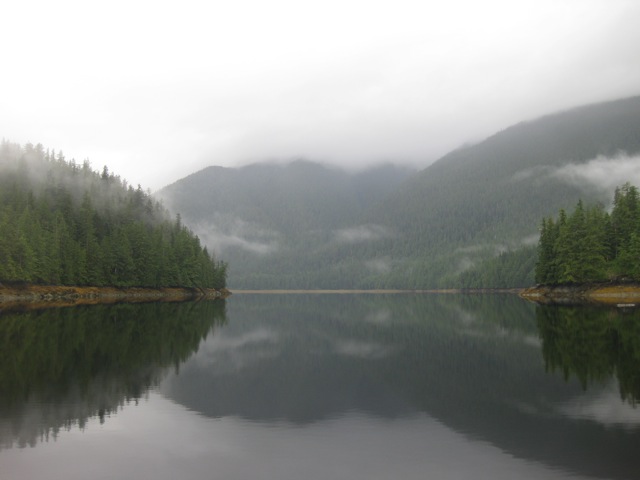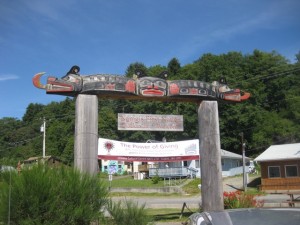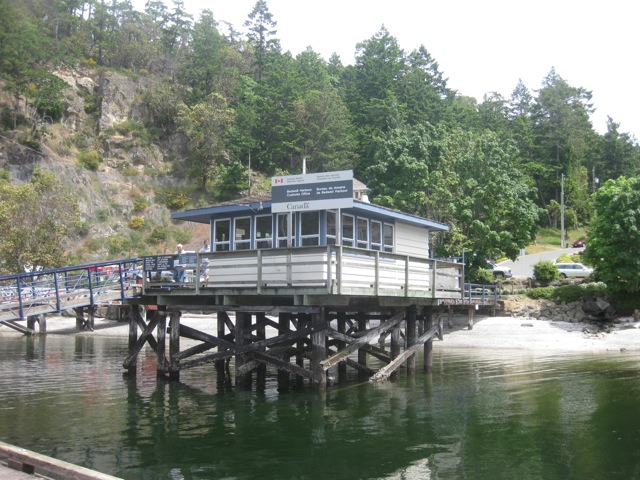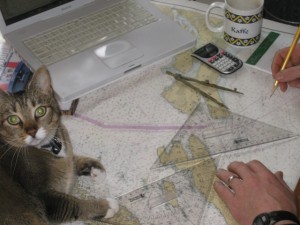
Most of the time we plan for out-of-the-way anchorages
In a couple of months we’ll be taking the David B on a 12-day trip from Bellingham to Ketchikan. Our cruise is a learning cruise we’ve created for other boaters who are interested in a hands-on experience in the Inside Passage. We’ve done this trip for several years in a row now and each year the planning gets a little easier. If you are thinking about, or getting ready to do your own cruise in the Inside Passage, here are some planning tips that you might find useful.Each year when we get ready to head north, I go through a series of questions about the trip such as:
- What are my time constraints?
- How far will we go?
- What are our daily itineraries?
- What are our planned activities?
- What did I needed to know for Canada Customs and US Customs?

The Killer Whales come to visit us sometimes
Time Constraints: In years past we’ve done the Bellingham to Ketchikan leg in six-days, eight-days, and twelve-days. I recommend a minimum of twelve. I would personally love to take three or four weeks to get to Ketchikan, as I love to meander, but since the David B is a tour boat, our time constraint is based on the amount of time that our passengers can take for vacation. In planning for your own trip you’ll want to think about your own time constraints, such as work, family obligations, and financial concerns. If you are going as far as Juneau or Sitka, you’ll want to take a minimum of eight weeks to cruise round-trip. You could cruise for years in the Inside Passage and never see everything. I’ve talked with retired people who cruise one section of the Inside Passage for a whole summer, then another section each subsequent year.

Alert Bay is a common stop along the Inside Passage
How Far: Everyone’s boat goes a different speed. Most boats are faster than ours. The David B cruises along at about six and a half knots. The mileage between Bellingham and Ketchikan is roughly 680 nautical miles so we plan make an average of fifty-eight nautical miles per day, which works out to being about eight hours underway. Since the Inside Passage isn’t a static body of water, we also figure in the currents, which can change the number of hours per day we’re underway. There are a few places, such as Dodd Narrows and Yuculta Narrows where our arrival is based on the time of slack water. Queen Charlotte Sound and Dixon Entrance are weather dependent. We spend several days prior to crossing tracking the weather. We’ve changed our plans on a couple of occasions to either arrive ahead of a system, or wait out the bad weather.
Daily Itineraries: I like to consider the distance between anchorages for each day, so we can plan where we’ll anchor each night. We love anchoring since it’s a good way to experience nature, so our priority is to look for interesting, out-of-the-way anchorages. Other people might prefer tying to docks. Either way, I find it useful to pre-plan some potential locations for each day. We try to avoid fixed destinations because you never know when you might spend and unexpected hour with a pod of killer whales.

We also like to visit ancient trees
When I’m planning our itinerary I use several books: Exploring the South Coast of British Columbia and Exploring the North Coast of British Columbia. the Coast Pilot 7, the Canadian Sailing Directions, Local Knowledge, NOAA’s Tide Prediction Tables and NOAA’s Tidal Current Prediction Tables. I also have my chart program, GPSNavX open, as well as the tide and current program that we use on our navigation computer. I like to check the paper prediction tables with the one on my computer. It’s a little redundant, but I’m less likely to make a mistake if I double check my math. The first year we went north I also used a paper chart posted on the wall and a set of dividers. I enjoyed daydreaming about our trip as I familiarize myself with the layout of the geography by I walking my dividers up and down the route I was planning. It helped me think about distances between the places I hoped to visit. I’ll spend more time on charts in an upcoming article.Planning for Activities: My favorite activities are nature based. I love walking in the woods, watching birds, whales, and other animals, and I love having an hour or so to hop in a kayak and slowly paddle around an anchorage. When I’m planning an itinerary, I take into account side-trips, such as a stop for hot-springs or a walk through an abandoned cannery. Maybe your ideal trip in the Inside Passage is different. There are many interesting places to visit. Your interests might to tie up at small marina/resorts or towns. If that’s the case you’ll be able to check out the destinations section right here on Cruising Northwest to do research for your trip.

Bedwell Harbour Customs Dock
Travel Between the United States and Canada – Customs: If you are traveling from the US to cruise the Inside Passage, you’ll need to bring your passport and have a basic understanding of what Canada Customs and US Customs require.
Clearing into Canada – Most US boaters will clear Canada Customs in Bedwell Harbour, however, customs docks are available in Victoria, Sidney, Nanaimo, and Vancouver. The customs experience is usually simple. It most often means you will tie to a specific customs dock, pick up a special telephone and call. The Customs officer will ask for the passport numbers, date and place of birth for each traveler. You will then be asked if you have any alcohol, tobacco or firearms. We carry bear spray on board and always declare it. They will also ask you about specific food items. In Canada, you cannot bring in any food that has: a pit, a core, or an eye. In other words, fruit like, apples, cherries or potatoes are forbidden. If you have those they will kindly ask you to place them in the garbage provided. After you have been questioned, you will be given a CANPASS number to post in your boat’s window. Also while you are on the phone with customs, your passengers and crew must remain on board.
A consideration that Americans need to be aware of is that Canada considers a Driving while Under the Influence (DUI) offense a felony. If you or someone traveling with you has had a DUI in the last ten years, you might be denied entry into Canada. You can apply for a Temporary Resident Permit. The cost is two hundred dollars. For up-to-date information on Canada Customs, here’s a link for non-Canadians: http://www.cbsa-asfc.gc.ca/publications/pub/bsf5082-eng.html
Checking In with US Customs and Boarder Protection Checking in with US Customs in Ketchikan involves a phone call when you get tied up. US Customs and Boarder Protection will come to your boat. While you wait for Customs to show up, everyone on board is required to remain on the boat and no one else is allowed to come on board. When the officer arrives, they will ask you if you bought anything in Canada and will question you about your galley stores. Food that is not allowed into the US from Canada includes, tomatoes, beef, eggs, and citrus. Some items they will allow if they were purchased in the US, are still labeled, and you can provide a receipt. The experience is usually easy and painless. For information on US Customs visit their website:
US Customs and Boarder Protection – http://www.cbp.gov/xp/cgov/travel/
Occasionally, US Customs and Border Protection or Canada Border Services Agency may search your boat. We’ve been searched by both several times. The officers have always been friendly and professional. Mostly they wanted to see our galley stores and alcohol. They also wanted to make sure that were not hiding any firearms. Also, if you are traveling with children and only one parent is on board you will need to have a notarized letter stating that your child is legally allowed to cross the border. If you or others on your boat are foreigners, you might need to check to see if you will need a visa.
In planning for our cruises in the Inside Passage, I start with some very broad topics to help me determine our itinerary. I also take the time to review any changes in what I’m allowed to bring into Canada and the US. Once I’ve decided on what our itinerary and I know what the rules are for customs, I can begin to concentrate on some other aspects of the trip. Next week I’ll talk about outfitting your boat for cruising in the Inside Passage. If you have anything you would like to add about planning a short or long cruise, I’d enjoy hearing your tips.
Please comment below!
[divider]


Very helpful. Departing Anacortes for Ketchikan in July, 25 MacGregor sloop with friends. Haven’t been up there since 1958. Trying to figure out how to minimize QAueen Charlotte and Dixon entrance. Was there aboard 88 ft USC&GSS Lester Jones during international Geophysical Year (57) and established chart depths for Moira Sound arms. A bit rusty, but have MV Masters Lic for Admiralty Inlet to Point Baker. Advice?
Hi Charlie,
Christine is up in Alaska right now, just beginning an 8 day cruise. When she is connected to technology again I know she’ll provide some info.
Thanks for checking out CruisingNW!
All the best,
Troy
Hi Charlie – Thanks for the question. When we are planning to cross Queen Charlotte and Dixon Entrance, we start watching the weather a few days out to plan for which day we want to go. We also leave early in the morning (5am) since it’s usually a little more calm. A good anchorage for going north before Queen Charlotte is Blunden Harbor and for Dixon Entrance is Brundage Inlet on Dundas Island.
I hope this helps!
-Christine
Greetings! We sailed north in 2006 from your region to AK. We are now headed south and wonder if there is any way around having to detour to Prince Rupert to clear in to Canada when southbound? Metlakatla? By phone? Any tips on that subject? Thanks!
Hi, We couldn’t get everyone on crew cleared for this year. Had to leave after Sept. 15th, so spent our time in San Juans and Gulf Islands visiting old haunts instead. First time ever this late in the year and it was (brrrrr) cold. Ketchikan next year (and I sure wish it could be in a bigger boat).
Charlie
Were leaving tomorrow for ketchikan . cant wait. wish it was warmer like last year. oh well what else can i complain about. any good places anyone recommends along the inside passage?
john
Hi,My brother and I are planning to head north from La conner.Although I have tons of boating experience,I’ve been on kauai for 45 years so it is all on canoes in big water.Steve,my brother fished quite a bit off his small boat in Forida.WE are total greenhorns when it comes the inside passage and was wondering how we could hook up with another boat that knows where there going{local knowledge}Thankyou,mary
Hello, Thanks for this site. Am planning a trip from Oak Harbor to Southeast Alaska. My main concern is places to get fuel every 100 miles or so. Is there a way to pre-determine good places?
Hi I had a dwi 3 years ago in homer alaska and I’m in Bellingham now can I sail my boat straight threw to Ketchikan with out stopping in Canada and be safe
unless things have changed what you suggest may not be a good idea canada is truly honesty is the best policy country you can talk to canadian customs before you leave and see the other alternative and it is a major one would be to forego the passage and navigate outside vancouver island this is truly a last resort
Great information. I lived on a boat in Southeast Alaska when I was a young man. As a helicopter mechanic I have flown over all of Southeast Alaska and would love to return one day to cruise the inside passage for an epic venture. Hopefully I can make it happen someday.
Do you still do your 12 day trips from Bellingham to Ketchikan? Do you have a schedule for 2021? I am thinking of buying a boat in Ketchikan and brining her back to Bellingham. I am an experienced mariner and former Nordic Tug owner but new to the inside passage. Your trip north would be the perfect way to gain experience. Thank you.
Hi Martin – I’m sorry, I just got this note today. Yes, we still do the 12-day trips to Ketchikan from Bellingham. We are sold out for this season, and are likely going to have to modify it this year due to COVID. I think there is still a cabin open for 2022. Our website is northwestnavigaion.com if you want to have a quick look.
-Christine
Thanks for sharing such great information. It is really helpful to me. I always search to read the quality content and finally I found your post. Keep it up, keep posting!